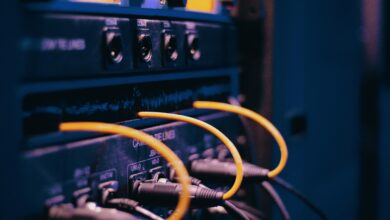How Edge Computing is Enhancing Data Processing: A Comprehensive Guide

In the era of digital transformation, data processing has become a cornerstone of modern technology. As the volume of data generated by devices, sensors, and applications continues to grow exponentially, traditional cloud computing models are facing challenges in terms of latency, bandwidth, and scalability. Enter edge computing , a revolutionary paradigm that brings computation and data storage closer to the source of data generation. This approach is transforming industries by enhancing data processing capabilities, enabling real-time insights, and improving overall system efficiency.
In this guide, we’ll explore how edge computing works, its benefits, and the ways it is enhancing data processing across various sectors.
What is Edge Computing?
Edge computing refers to a distributed computing framework that processes data near the “edge” of the network—close to where the data is generated, rather than relying on centralized cloud servers located far away. By decentralizing data processing, edge computing reduces latency, minimizes bandwidth usage, and ensures faster decision-making.
Key Components of Edge Computing
- Edge Devices : Sensors, IoT devices, smartphones, or any hardware capable of collecting and processing data locally.
- Edge Nodes : Local servers or gateways that aggregate and process data from multiple edge devices.
- Centralized Cloud : Acts as a backup for storing and analyzing large datasets that don’t require immediate action.
How Edge Computing Enhances Data Processing
Edge computing addresses many limitations of traditional cloud-based systems, particularly in scenarios requiring real-time responses. Here’s how it enhances data processing:
1. Reduced Latency
- Challenge : Sending data to a remote cloud server for processing introduces delays, which can be critical in time-sensitive applications like autonomous vehicles or healthcare monitoring.
- Solution : By processing data locally at the edge, latency is significantly reduced, enabling near-instantaneous responses.
Example : In self-driving cars, edge computing allows onboard systems to process sensor data in milliseconds, ensuring quick reactions to obstacles or traffic signals.
2. Bandwidth Optimization
- Challenge : Transmitting massive amounts of raw data to the cloud consumes significant bandwidth, leading to congestion and higher costs.
- Solution : Edge computing filters and processes data locally, sending only relevant information to the cloud. This reduces the amount of data transmitted over the network.
Example : Smart cameras equipped with edge AI can analyze video feeds locally, sending only alerts or specific frames (e.g., license plates) to the central server instead of streaming entire videos.
3. Improved Reliability
- Challenge : Dependence on cloud connectivity makes systems vulnerable to outages or disruptions in internet access.
- Solution : Edge computing enables offline operation, ensuring continuous functionality even when connectivity is lost.
Example : Industrial machinery equipped with edge devices can continue operating autonomously during network failures, preventing costly downtime.
4. Enhanced Security and Privacy
- Challenge : Transmitting sensitive data to centralized servers increases the risk of interception or breaches.
- Solution : Edge computing keeps sensitive data localized, reducing exposure to potential threats. Additionally, encryption and anonymization techniques can be applied at the edge before transmitting aggregated data.
Example : In healthcare, wearable devices can process patient data locally, sharing only anonymized summaries with cloud systems to comply with privacy regulations like HIPAA.
5. Scalability and Flexibility
- Challenge : Centralized cloud infrastructure struggles to scale efficiently with growing data volumes and device connections.
- Solution : Edge computing distributes workloads across multiple edge nodes, making it easier to scale horizontally without overwhelming the central system.
Example : Retail chains use edge computing to manage inventory and customer analytics at individual store locations, avoiding bottlenecks in centralized databases.
Applications of Edge Computing Across Industries
Edge computing is already revolutionizing numerous industries by enhancing data processing capabilities. Below are some prominent examples:
1. Healthcare
- Wearable health monitors and medical devices leverage edge computing to provide real-time diagnostics and alerts.
- Remote surgeries powered by edge-enabled robotics ensure precision and low latency.
2. Manufacturing
- Predictive maintenance systems analyze machine performance data locally to detect anomalies and prevent breakdowns.
- Quality control processes use edge AI to inspect products in real-time, reducing defects.
3. Transportation
- Autonomous vehicles rely on edge computing to process sensor data and make split-second driving decisions.
- Traffic management systems optimize signal timings based on real-time traffic patterns analyzed at the edge.
4. Retail
- Smart shelves equipped with edge sensors monitor stock levels and trigger restocking alerts.
- Personalized shopping experiences are enhanced through real-time analysis of customer behavior using edge analytics.
5. Smart Cities
- Surveillance cameras with edge AI identify suspicious activities and notify authorities instantly.
- Energy grids utilize edge computing to balance supply and demand dynamically, improving efficiency.
Benefits of Edge Computing for Data Processing
The adoption of edge computing offers several advantages that go beyond traditional cloud-based approaches:
- Real-Time Insights : Enables immediate decision-making by processing data close to its source.
- Cost Efficiency : Reduces bandwidth costs and minimizes reliance on expensive cloud infrastructure.
- Improved User Experience : Delivers seamless interactions in applications like gaming, streaming, and augmented reality.
- Energy Savings : Processes data locally, consuming less power compared to transmitting it to distant servers.
- Resilience Against Failures : Ensures uninterrupted operations even during network disruptions.
Challenges of Edge Computing
While edge computing offers numerous benefits, it also presents certain challenges:
- Device Management : Managing and updating software across thousands of distributed edge devices can be complex.
- Security Risks : Edge devices may become targets for cyberattacks if not properly secured.
- Resource Constraints : Limited processing power and storage capacity on edge devices can restrict their capabilities.
- Interoperability Issues : Integrating edge solutions with existing IT infrastructure requires careful planning.
Future Trends in Edge Computing
As technology evolves, edge computing is expected to play an even more significant role in shaping the future of data processing. Some emerging trends include:
- 5G Integration : The rollout of 5G networks will further enhance edge computing by providing ultra-low latency and high-speed connectivity.
- AI at the Edge : Combining artificial intelligence with edge computing will enable smarter, context-aware applications.
- Hybrid Architectures : Organizations will adopt hybrid models combining edge and cloud computing to optimize performance and cost.
- Edge-as-a-Service (EaaS) : Cloud providers are offering managed edge services, simplifying deployment and maintenance for businesses.




